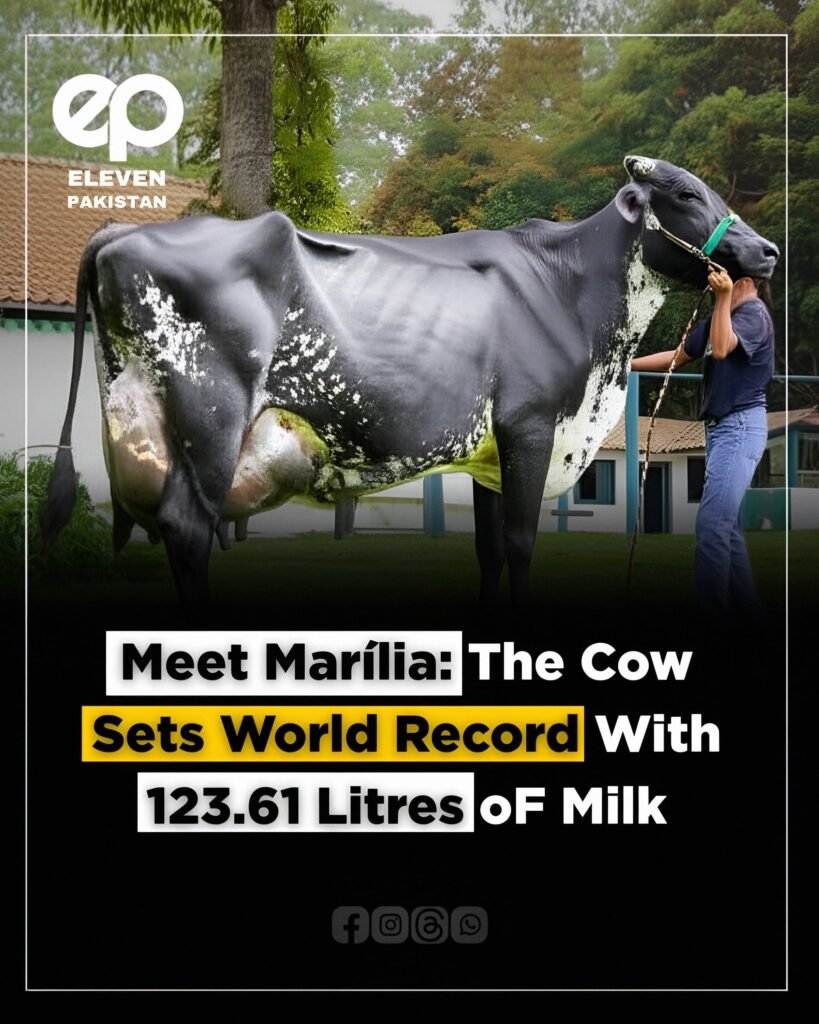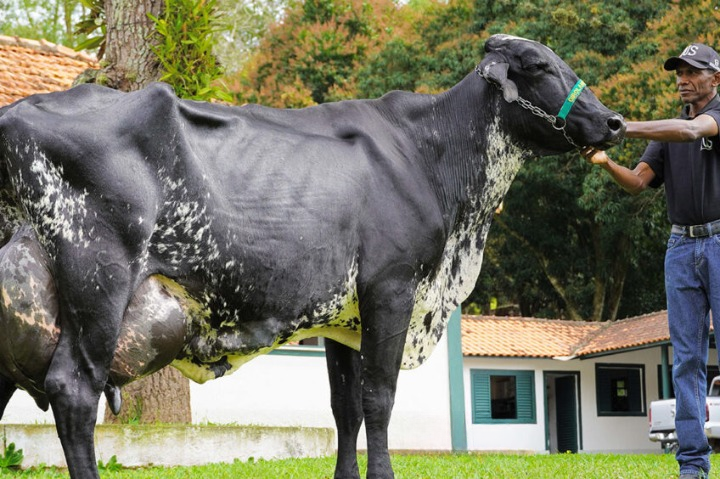In a groundbreaking moment for the global dairy industry, a cow named India from Brazil has achieved what many believed to be nearly impossible: she has officially broken Brazil: Cow breaks world record for milk production solidifying her place in agricultural history. India is a Girolando cow, a breed that exemplifies the power of genetic innovation and careful animal husbandry. Her astonishing performance has not only garnered national pride but has sparked worldwide attention across the agricultural, scientific, and environmental communities.
This document offers a deep dive into the life of India, the science behind her incredible feat, and the wider implications of her record on sustainable dairy farming in tropical countries.
The Birth of a Legend
India was born on a mid-sized dairy farm in Minas Gerais, one of Brazil’s most agriculturally productive states, renowned for its dairy sector. From the moment she was born, India exhibited traits that caught the attention of her handlers. She was healthy, vibrant, and grew at an exceptional pace.x
Her lineage was carefully crafted through generations of selective breeding. The Girolando breed is a hybrid of the Holstein, known globally for its high milk yield, and the Gir, a hardy Indian breed famed for its resilience in hot climates. This cross-breeding was part of Brazil’s national strategy to produce dairy cows capable of thriving in tropical environments while also delivering high milk outputs.
India represented the best of both worlds—she inherited the production potential of the Holstein and the heat resistance and disease tolerance of the Gir. From an early age, her handlers suspected she had the potential to surpass expectations.
Understanding the Girolando Breed
The Girolando is Brazil’s most widely used dairy breed, making up more than 80% of the country’s dairy cattle. Its popularity is due to its adaptability to tropical environments and its ability to produce high quantities of milk even under environmental stress.
Key characteristics of Girolando cows include:
- High adaptability to heat and humidity.
- Strong immune systems resistant to tropical diseases.
- High fertility and longevity.
- Daily milk yields that can exceed those of purebred tropical breeds.
India was an elite example of this breed. Her genetic profile was a carefully calculated result of decades of research into optimizing dairy production in Brazil.

Daily Life on the Farm
India lived on a farm that practiced modern dairy farming techniques combined with traditional care methods. She was kept in a semi-open barn that allowed for natural ventilation, essential for cows in Brazil’s warmer regions. The barn was equipped with fans, misters, and padded resting areas to ensure cow comfort.
Her diet was scientifically designed and updated regularly. She consumed a balanced combination of:
- Silage (fermented green fodder like corn or sorghum)
- Grains (such as soy and maize for energy)
- Minerals and vitamins (for immunity and bone health)
- Freshwater (at all times, ensuring proper hydration)
Veterinarians visited weekly and were on-call 24/7. India’s health was closely monitored using wearable tech that tracked her activity levels, body temperature, and milk output.
The Record-Breaking Feat
India’s most staggering accomplishment was producing a total of 127,000 liters of milk during her lifetime. To understand the magnitude of this achievement:
- A typical dairy cow produces about 6,000 to 10,000 liters per year.
- High-producing cows can reach 12,000 to 15,000 liters per year under optimal conditions.
- India exceeded these figures consistently over multiple lactation cycles.
At her peak, India produced over 60 liters of milk per day, while the average cow typically produces 20-30 liters. Her ability to maintain such output without signs of stress or declining health was considered nothing short of extraordinary. READ NEXT https://elevenpakistan.com/study-girlfriends-are-almost-always-right-during-arguments/
Her lifetime production was verified using digital milking systems that recorded every milking session, ensuring complete accuracy and transparency. These records were audited by national dairy organizations before being submitted to international record authorities.
Reaction and Recognition
When the record was confirmed, the farm staff and owners were overwhelmed with emotion. For them, India was more than a dairy cow—she was a symbol of hard work, dedication, and love for animals.
“India is family. She’s lived with us for over a decade, and we’ve watched her grow from a calf to a global record-holder. It’s surreal,” said the farm’s owner in an emotional interview with Brazilian news outlets.
The Brazilian Association of Girolando Breeders recognized India’s achievement, and the data is currently under review by the Guinness World Records and other international livestock monitoring bodies.
Her achievement was featured in agriculture expos, scientific journals, and even government policy papers discussing the future of livestock farming in Brazil.
The Science Behind the Success
India’s record was not just the result of good fortune; it was the outcome of a carefully managed combination of genetics, nutrition, veterinary science, and environmental control.
Genetic Engineering
India’s lineage was selected using advanced genomic tools to identify cows with the best potential for high milk yield. This method, called genomic selection, involves:
- DNA testing of calves and parent cows.
- Identifying markers linked to high productivity.
- Selecting only those with optimal genetic profiles for breeding.
Nutrition Planning
Her diet changed as she aged. Nutritionists worked with veterinarians to adjust her feed to match her milk production cycle. During lactation, she received energy-dense food to support her metabolism.
Health Monitoring
Preventive care was key. India received regular vaccinations and deworming treatments. She was also checked for signs of mastitis, lameness, or digestive issues, all of which can reduce milk output if untreated.
Broader Implications for Global Dairy Farming
India’s achievement has global significance. She represents the possibilities of high-yield, climate-resilient dairy farming, especially in countries with hot climates. Her success story is being studied in:
- Africa, where dairy farming faces challenges from heat and disease.
- Southeast Asia, where smallholder farmers are seeking more productive yet hardy cows.
- India, where Gir cattle originated and where crossbreeding programs are growing.
India’s success proves that it’s possible to:
- Improve milk production without compromising animal health.
- Breed cows suited for climate challenges.
- Maintain sustainable and ethical farming practices.
The Legacy of India
India has now entered retirement. She lives in a spacious, shaded area of the farm and is visited frequently by students, veterinarians, and agricultural journalists. Her genetics will be preserved through:
- Artificial insemination: Her embryos and semen (from relatives) are in high demand.
- Cloning research: Scientists have shown interest in cloning India to replicate her unique attributes.
- Case studies: India is now part of livestock science curricula in Brazil.
Her impact goes beyond milk production. She has become a symbol of what is possible when innovation, compassion, and science come together.
Conclusion
India, the record-breaking cow from Brazil, has forever changed the standards of dairy farming. Her incredible life is not just a celebration of milk yields but also a story of dedication, advanced science, and sustainable animal care. Her story continues to inspire farmers, researchers, and policymakers around the world.
From a simple farm in Minas Gerais to becoming a global icon, India has proven that greatness can come from anywhere—and sometimes, it moos.
READ NEXT



